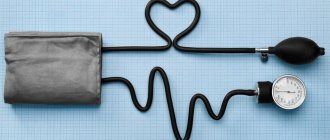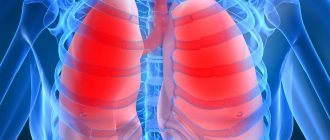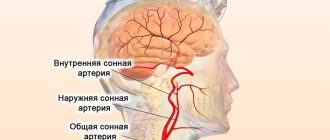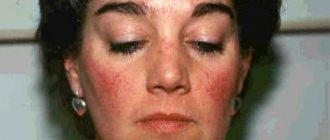Inflammation of the walls of blood vessels or vasculitis is a pathology of the human body that affects various blood vessels (veins, arteries).
As a result, blood circulation is disrupted and the death of tissues supplied by “sick” vessels is observed.
Let us consider in more detail the symptoms of inflammation of the walls of blood vessels and methods of treating this disease.
General picture of the disease
Vasculitis includes all vascular lesions - arterioles, veins, arteries, capillaries that have immunopathological causes. The latter refers to a specific disruption in the functioning of the immune system: wall cells are mistakenly identified as foreign, and, accordingly, are attacked.
The release of antigens into the blood leads to the formation of a large number of immune complexes. After some time, these formations become fixed on the walls, macrophages and leukocytes migrate to them, phagocytosis, cell lysis, and platelet aggregation begin, which ultimately leads to the destruction of the artery, vein or capillary. The walls of blood vessels become permeable, and as the disease progresses, necrotic changes begin.
An atypical increase in the number of immune complexes in the blood serum is one of the diagnostic signs.
Inflammation of the vessel wall prevents normal blood flow, resulting in damage to the body organ served by the affected vessel. Thus, with cerebral vasculitis, the occipital part of the brain does not receive oxygen, and as a result, visual disturbances are observed. And inflammation of the veins of the lower extremities is accompanied by skin rashes and joint pain.
The exact cause of the disease remains unknown. What is known for certain is that, in addition to autoimmune processes, vasculitis is provoked by Staphylococcus aureus and the hepatitis virus. Localization is unpredictable. Vasculitis of the legs, brain vessels, and small vessels of the kidneys are among the most common forms of inflammation.
Inflammatory diseases of blood vessels
Vasculitis refers to any inflammatory lesions of blood vessels, regardless of their location and diameter, as well as the nature of the pathological process. For ease of diagnosis, they are usually classified according to different criteria. Depending on the type and diameter of blood vessels, there are several types of vasculitis:
- arteritis - inflammation of the walls of the arteries;
- phlebitis - inflammatory diseases of the veins;
- capillaritis and arteriolitis - inflammation of capillaries and arterioles.
The following classification distinguishes several types of arteritis, depending on the location of the process in the walls of the arteries:
- endoarteritis - inflammation of the inner layer of the vessel;
- mesoarteritis - dangerous inflammation of the middle (muscular) layer;
- periarteritis - the process affects the outer layer of the artery;
- Panarteritis is a complex process that spreads simultaneously to all layers of the artery.
Due to their occurrence, there are also two main types of vasculitis:
- primary - develops as an independent disease;
- secondary - manifests itself as a symptom or complication of the underlying disease.
REFERENCE! Systemic vasculitis is considered the most complex and dangerous form. This is a condition in which generalized inflammation of blood vessels occurs, regardless of their location and diameter.
Causes of vasculitis
The causes of primary vasculitis often remain unclear. Secondary inflammation of blood vessels can be a consequence of various viral diseases that occur with damage to the walls of veins or arteries. Pathology can also develop due to intoxication or exposure to certain medications. One of the causes of vasculitis is considered to be viral hepatitis, an inflammatory disease of the liver in which the pathogen is found in the general bloodstream.
Inflammation of blood vessels can also be of an autoimmune nature. The process is associated with malfunctions of the immune system, in which it perceives the tissue of its own blood vessels as a foreign protein. This leads to a generalized inflammatory reaction and a significant deterioration in well-being. After taking medications that inhibit the immune system, the patient's condition stabilizes.
Clinical picture
Inflammation of the vascular wall can occur in a specific area or affect most of the veins and arteries. Depending on the extent of the disease, its clinical signs will differ. Thus, with systemic vasculitis, the patient complains of general weakness, increased body temperature, sudden weight loss, aching muscles and joints.
Also, symptoms will differ depending on the location of the damaged vessels. There are several main symptom complexes that appear when certain organs are damaged.
We also recommend reading: Prevention of vascular diseases
- The skin is one of the most common sites of manifestation of vasculitis. Various types of rashes may appear on it, including pinpoint or large hemorrhages, nodules, urticaria, and discoloration of the skin in the form of spots. In advanced cases, ulcers form, often on the surface of the lower leg.
- Limbs and peripheral nerves that participate in their innervation - the disease is also associated with damage to small capillaries. It causes various sensory disturbances in the hands and feet, tingling and numbness, and muscle weakness.
- Brain - a decrease in the intensity of blood circulation in this organ is life-threatening and can cause a stroke. Attacks of convulsions, disorientation in space, deterioration in coordination of movements, and painful sensations in the head and eyes are also possible.
- Organs of the digestive tract - inflammation of the vessels of the stomach and intestines is accompanied by acute pain in the abdomen. Various digestive disorders, nausea and vomiting, and blood in the stool are also observed.
- Heart - if the arteries and veins that participate in the blood supply to the myocardium become inflamed, this leads to painful sensations in the chest and heart rhythm disturbances. If treatment is not started in time, there is a risk of myocardial infarction.
- Poor blood circulation in the kidneys is life-threatening. In the initial stages, swelling is observed, especially in the lower extremities, and lower back pain. One of the characteristic symptoms is a constant increase in blood pressure due to delayed fluid outflow.
- Joints - with vasculitis, pain of varying intensity and decreased mobility are observed. The clinical picture is accompanied by swelling of small and large joints.
It is important to determine the cause of pain, swelling and other symptoms in the initial stages. Vasculitis can occur with both a characteristic clinical picture and less severe symptoms. In some cases, it must be differentiated from migraine, sinusitis, bronchial asthma and other diseases.
Inflamed vessels are often clearly visible under the skin
Diagnostic methods
It is impossible to determine vasculitis based only on external symptoms. In addition, they can be erased or develop over a long period of time. For a more accurate diagnosis, instrumental and laboratory techniques are used that will allow one to assess the condition of the blood vessels and distinguish their inflammation from other diseases.
- General and biochemical blood tests are the first stage in determining vasculitis. Typical disorders such as anemia (decreased number of red blood cells), increased levels of platelets and leukocytes are detected. You can also determine an increase in the erythrocyte sedimentation rate, an increase in the level of C-reactive protein and fibrinogen.
- An immunological blood test is informative in diagnosing some types of specific vasculitis. Antineutrophil cytoplasmic antibodies are detected in the blood, which indicate the development of autoimmune inflammation.
- Blood tests to determine infectious diseases are prescribed according to indications. Thus, vasculitis can develop as a symptom of viral hepatitis.
- A urine test will indicate the condition of the kidneys. If their work is disrupted, protein impurities and red blood cells, which are normally absent, are found in the samples.
- Instrumental diagnostic methods (ultrasound, radiography) are informative for assessing the condition of the organs of the thoracic, abdominal and pelvic cavities. Thus, if damage to the blood vessels of the bronchi and lungs is suspected, chest X-ray and heart X-ray - ECHO-cardiography - are prescribed. A computed tomography or magnetic resonance imaging scan may also be required.
- A biopsy is an invasive procedure that involves examining a sample of tissue from internal organs. It is performed under local anesthesia, and the biopsy specimen, after special preparation, is examined under a microscope. With vasculitis, pinpoint hemorrhages and other signs of disruption of the integrity of blood vessels can be detected.
IMPORTANT! Symptoms of vasculitis may develop slowly. This is due both to the characteristics of the diseases and to the ability of the vascular system to partially compensate for circulatory disorders.
Treatment of vasculitis
Treatment is selected individually and depends not only on the stage of the disease, but also on the location of the damaged vessels. Thus, if the functioning of vital organs (heart, lungs, kidneys, central nervous system) is disrupted, hospitalization may be required. The greatest difficulty is presented by systemic vasculitis, which develops with damage to large and small vessels throughout the body. The basic regimen includes intravenous administration of glucocorticosteroids (hormonal anti-inflammatory drugs) and cytostatics (immunosuppressants). To stabilize the patient's condition and achieve remission, a combination of prednisolone with cyclophosphamide, intravenous immunoglobulin and a specific procedure - plasmapheresis is used.
The clinical picture of vasculitis may differ, so it must be distinguished from other diseases with similar symptoms
Many patients manage to maintain a state of stable remission for a long time. After stabilization, you can gradually reduce the dosage of the drugs, and then stop using them. In case of relapse (repeated exacerbation of the disease), the regimen is repeated again. It is important to understand that immunosuppressant medications with corticosteroids may have side effects. They inhibit the functioning of the immune system, and with prolonged use they can cause irritation of the mucous membrane of the bladder, decreased bone strength (osteoporosis) and other disorders.
REFERENCE! Medicines prescribed for the treatment of chronic vasculitis become addictive over time. It is important to follow the doctor’s instructions and not take them unless absolutely necessary, or in a state of remission.
Classification of vasculitis
Since the disease can affect any of the blood vessels and any part of the circulatory system, this disease has many forms.
According to the type of source of inflammation of blood vessels, they are divided into two types:
- primary - inflammation of the walls itself as the starting point for the development of the disease;
- secondary - arising as a result of an infectious, allergic disease or even injury.
Based on the caliber of the affected vessels and the area of distribution, vasculitis is considered in this way.
- Segmental - the focus of inflammation is one of the vessels. In turn, segmental are divided into arteritis - large arteries are affected, arteriolitis - arterioles, phlebitis - veins of the lower extremities, for example, and capillaritis.
- Systemic - a general lesion of the circulatory system without a specific localization, for example, lupus or rheumatoid vasculitis. The majority are characterized by rashes on the legs, even the appearance of ulcers. The veins in the legs are the most vulnerable in the body, as they are subject to the greatest load, and vasculitis manifests itself in the “weakest point.”
According to the localization of the disease on the walls, there is the following classification.
The structure of the vessel wall. Click to enlarge.
- Endovasculitis - the inner wall of the vessel becomes inflamed.
- Mesovasculitis - here the disease affects the middle layer.
- Perivasculitis - the outer layer of the vessel is affected.
- Panvasculitis is inflammation and destruction of all layers of the wall. This is the most dangerous type of disease.
There are other forms of the disease with extremely characteristic symptoms. Often such diseases have a clear connection to region or race, for example, Takayasu arteritis.
This is a lesion of the aorta, which in 8 out of 9 cases is recorded in Asian women. Vasculitis of the lower extremities or brain is much less specific, and, unfortunately, widespread.
Causes
Over time, varicose veins lead to deformation of blood vessels, which in turn causes disruption of blood flow, increases the risk of thrombosis and occlusion (blockage of the lumen of the vessel). Constant increased pressure and changes in the structure of the vein lead to inflammation of its walls.
It should be recalled that phlebitis is the result of infectious agents entering the blood, exposure to certain medications and injury to blood vessels. In rare cases, the cause of phlebitis is inflammation of the tissues adjacent to the veins.
There are several factors in the development of phlebitis that many encounter in their lives:
- sedentary lifestyle;
- excess weight;
- varicose veins and its treatment with sclerotherapy;
- genetic predisposition;
- infectious diseases of the veins;
- vascular injuries;
- incorrect walking style when the foot is turned inward.
A sedentary lifestyle and excess weight increase the load on the walls of the vessels of the lower extremities, because of this, the outflow of blood slows down, and inflammation can begin under the influence of a delay in metabolic products or due to an increase in blood volume in this area.
Varicose veins often cause phlebitis, as it is treated with sclerotic drugs that increase the tone of the muscular part of the vessel. But these drugs are a rather strong chemical aggressor, which can provoke local adhesion of the vein wall or its inflammation.
The veins in the legs can become inflamed for various reasons, but the main one is varicose veins. Failure to close the venous valves leads to improper blood flow through the vessels, causing them to expand, and subsequently their walls become inflamed.
Factors that can provoke the development of an acute inflammatory process in the venous vessels are very diverse. The protocol for treating the pathology will depend on them.
Doctors consider varicose veins to be the main cause of phlebitis. In addition, we can name a number of other factors that can provoke the development of pathology:
- Excess weight: this puts even more strain on the veins.
- Low physical activity: it has become the scourge of the 21st century.
- Prolonged vertical position, for example, store clerks are forced to stand behind the counter all day.
- Abnormal bowel movements, for example constipation.
In some cases, allergic reactions can also trigger the development of the disease.
Much less often, the development of phlebitis is caused by injury to a vein or its damage as a result of the development of an infectious disease.
No matter what the cause of the disease is, it cannot be left without treatment, so as not to develop serious complications.
Symptoms of inflammation
It is quite difficult to identify them due to the feature described above: the disease is not limited to the destruction of the wall, but affects the organ. Of the general signs, vasculitis is characterized by all the typical features of inflammation:
- causeless weakness;
- elevated temperature;
- mild, non-localized pain, especially in the legs;
- decreased appetite.
Specific symptoms are associated with the type of inflammation and the nature of the affected area. Signs of damage to the veins of the lower extremities and arteries of the brain will be different.
- Skin rashes - most often observed on the legs, as they are associated with the destruction of subcutaneous vessels. However, they can also be observed in the joint area - knees, elbow bends. The rashes vary in size - from the size of a pea to the size of a quail egg, are bright red or purple in color, and are accompanied by swelling and itching. Rashes are a secondary symptom and, as a rule, do not transform into ulcers. The most common localization is on the lower extremities - legs and ankles.
- Ulcers in the mouth, pain in the abdomen are signs of impaired blood supply to the intestines. Here, inflammation can lead to extremely serious consequences: the intestinal walls become thinner, which can disrupt its integrity.
- If the brain is damaged, redness and itching in the eyeball, visual disturbances and short-term blindness are observed.
- Vasculitis of the cerebral arteries is accompanied by severe headaches, disturbances in memory, speech, and so on.
Damage to a large vessel is necessarily accompanied by characteristic symptoms of disruption in the functioning of the corresponding organ.
For example, vasculitis of the pulmonary vessels has all the signs of pneumonia, which is confirmed even by radiographic studies. And inflammation of the veins of the lower extremities is always accompanied by rashes, which somewhat facilitates diagnosis.
In general, damage to arteries is more severe than damage to veins and is more dangerous: unlike veins and capillaries, the functions of arteries are not duplicated, and it is impossible to redistribute them between other vessels.
Symptoms of phlebitis
It is quite difficult to recognize phlebitis on your own because its symptoms are often similar to a cold or sprain. Superficial inflammation of the blood vessels of the legs can be recognized by the following signs:
- acute pain at the site of the affected vein;
- constant muscle tension in the area of inflammation;
- fever, aching sensation;
- weakness;
- swelling in the area of inflammation.
Symptoms of deep phlebitis differ in that they are more pronounced due to the larger size of the veins themselves and the depth of their location. These include the following manifestations:
- severe swelling in the area of inflammation;
- acute pain when pressing on the affected area;
- change in skin color to bluish or purple;
- body temperature can reach 38-39 degrees;
- the patient feels weakness, nausea, dizziness.
The symptoms described above will indicate inflammation of a vein in the arm or leg, but there is also cerebral phlebitis - an inflammatory process in the vessels of the brain. This pathological condition is extremely dangerous because it disrupts the flow of blood from the brain and increases the risk of stroke. And you can recognize it by the following signs:
- severe aching pain in the back of the head or temples;
- increased fatigue;
- insomnia and migraines;
- high blood pressure;
- feeling of “pressure” on the eyeballs;
- exacerbation of neurological problems (nervousness, tearfulness, etc.).
Symptoms of phlebitis of the superficial veins of the legs
Acute superficial phlebitis of the lower extremities (as well as other parts of the body) is accompanied by pain in the inflamed veins, which become tense and seem to stretch. The person himself may notice that the skin over them has turned red and become hot to the touch.
Usually phlebitis manifests itself only with local signs, but in some cases a deterioration in the general condition is possible - a slight increase in body temperature, the appearance of malaise, and weakness.
In the absence of treatment or its untimely initiation, the acute process becomes chronic. This process occurs with less pronounced symptoms, or even without it. It becomes common for a person to feel heaviness in his legs, which quickly get tired and ache. The course is recurrent: with alternating exacerbations and remissions.
Symptoms of phlebitis of the deep veins of the legs
With acute inflammation of the deep veins, the leg becomes hot, sharp pain appears, especially when you try to squeeze the calf with your hand, after wearing uncomfortable shoes, or standing or walking for a long time.
The area of inflammation swells. Thickening and redness of the skin is not typical; on the contrary, it becomes milky white.
With this disease, the body temperature rises, the person notices rapid fatigue and weakness. Often acute phlebitis turns into thrombophlebitis with the formation of blood clots.
Chronic phlebitis of the deep veins manifests itself with the same symptoms, but they are moderate.
Various forms of the disease may present with characteristic symptoms. Most often, phlebitis of the lower extremities has the following symptoms:
- If phlebitis affects only the surface of the veins, then in the acute phase of the disease they become painful and tense. The skin in these places turns red and thickens, becoming hot to the touch. Sometimes you may notice an increase in body temperature.
- The chronic form of the disease does not have a clearly defined picture, the symptoms are smoothed out, and exacerbations occur periodically.
- If there is an inflammatory process in the deep veins, phlebitis of the lower extremities shows the following symptoms (the photo below demonstrates this): pain and swelling at the site of inflammation, the skin becomes milky white. The danger of this form of the disease is that it can quickly turn into thrombophlebitis, which occurs with the formation of blood clots.
- Cerebral phlebitis will certainly manifest itself as headache, hypertension, and neurological problems.
Diagnostics
Rashes on the legs, arms, and face, of course, are more specific signs of the disease than weakness or fever. In any case, they will make it possible to separate inflammation of small vessels from disease of large arteries or deep veins.
- At the second stage, histopathological studies are carried out: allergy tests, PRC-text, examination of immune complexes, and so on.
- Repeated studies of the respiratory and cardiovascular systems are carried out not only at the diagnostic stage, but also during treatment.
- To identify cerebral arteritis, MRI and angiography are performed. For leg veins, Doppler testing is indicated.
Treatment of vascular inflammation
Most of these diseases can be cured in the initial stages. Fortunately or unfortunately, not all forms of vasculitis are accompanied by high fever, which is often a reason to ignore the disease or use folk remedies.
For indolent inflammation or in the initial stages of the disease, drug treatment is completely sufficient.
- Disaggregants are drugs that affect blood thickness and prevent the risk of blood clots. When cerebral vessels are damaged, this is one of the most dangerous complications. And vein blockage is no less dangerous. However, in the final stages of the disease, antiplatelet agents can only maintain the patient’s condition stable.
- Non-steroidal anti-inflammatory drugs - parmidine, stugeron. For severe lesions, glucocorticoid drugs are prescribed.
- Anticoagulants are also used - heparin, syncumar.
Treatment is prescribed only after examination and consultation with all necessary specialists. With vasculitis, an individual approach is more important than anywhere else.
In extreme cases, surgical intervention is prescribed, usually when large vessels are damaged - the brain, heart, kidneys. Endarterectomy is used - removal of the cholesterol plaque, and endovascular removal of the entire section of the vessel. The latter method is also used for phlebitis of the veins of the lower extremities.
Due to the uncertainty of the causes of the disease, only general recommendations can be applied as prevention. Of course, a healthy diet and accessible exercise reduce the risk and in any case alleviate the course of the disease. The most obvious provocateur of inflammation is smoking. This factor should be excluded.
American cardiac surgeon Dwight Lundell, a specialist with 25 years of experience, came to the conclusion that the main cause of diseases of the cardiovascular system
human are
chronic inflammation of the walls of blood vessels
.
Dr. Landell reached this conclusion as a result of observations and research throughout his professional career.
The findings of an American doctor refute the theory that high cholesterol levels are the root cause of all vascular problems.
In other words, if a person’s blood vessels are healthy and not inflamed, then cholesterol moves freely through the vessels, is not deposited anywhere, does not settle or stick. And with inflamed blood vessels, cholesterol is deposited.
Treatment of vascular diseases
Drug treatment is used to improve blood circulation, clear it of plaques and increase the lumen in damaged capillaries. After diagnosis and diagnosis, the patient is prescribed drug therapy, which must be supported by a special diet.
Medications
For vascular damage, the following types of medications are used:
- Neurotropic substances. Necessary for normalizing blood flow and reducing the tone of the vascular system. Such drugs include Nitroglycerin, Eufillin and Reserpine.
- Calcium channel blockers. Used to strengthen vascular walls. Blockers are Nifedipine, Verapamil, Diazepam and Amlodipine.
- Heart medications are needed to correct the lack of oxygen in the brain. These include Cardiovalen and Adoniside.
- Enduracin is a medicine based on nicotinic acid. Used to improve the functioning of the vascular system.
- Herbal preparations like Cavinton and Bilobil are used to eliminate vascular spasms.
- To strengthen the vascular walls, Ascorutin, Venoton or Detralex are prescribed.
- Nootropic substances have a beneficial effect on the patient’s mental abilities. These include Nootropil and Phenotropil.
- To block spasms during migraine attacks, as well as to have a vasodilating and anti-inflammatory effect, Maxalt is prescribed.
- Anticoagulants are necessary to prevent blood clots from forming. These drugs include Heparin and Hirudin.
- Cavinton or Capillarin are used to cleanse the vascular system.
- ACE inhibitors are used to strengthen vascular walls and reduce blood pressure.
Surgery
More severe cases require surgery. The indication for it is the risk of developing blood clots - blockage of arteries and veins, which can lead to the death of the patient.
For the surgical treatment of vascular pathologies, the following methods can be used:
- Shunting. During the operation, the surgeon uses a shunt to block some sections of the arteries, allowing blood to flow through a different route.
- Stenosis. Artificial dilatation of the walls of blood vessels. This is achieved by installing a supporting frame into the damaged vessel.
- Carotid endarterectomy. The surgeon uses clamps to block the desired section of the artery, then makes an incision on the vessel and removes cholesterol plaques.
Causes of inflammation of the walls of blood vessels
Inflammation of blood vessels occurs as a natural reaction of the body to the effects of various infections: viruses, bacteria. The body reacts in exactly the same way to exposure to various toxins.
It is the regular consumption of toxins, which Dr. Landell includes all foods high in polyunsaturated carbohydrates and fats, that leads to vascular inflammation, in most cases becoming chronic.
Products that have such a negative impact on our health include all products high in simple processed carbohydrates, the main ones of which are sugar and flour. Abuse of foods high in omega-6 fats has an equally negative effect on blood vessels. These primarily include soybean oil, sunflower oil and corn oil.
Prognosis of Behçet's disease
Behçet's disease can come and go in unpredictable cycles.
Symptoms of the disease may subside slightly after approximately 20 years of illness. Despite the fact that it is impossible to cure Behcet's disease, the symptoms of the disease can and should be controlled. For example, untreated uveitis can lead to vision loss. Patients should be regularly examined by an ophthalmologist.
Other possible complications of Behçet's disease depend on which vessels are affected by the disease.
Konstantin Mokanov: Master of Pharmacy and professional medical translator
How does vascular inflammation occur?
The mechanism of vascular inflammation is as follows. When there is an excess of carbohydrates in the body, cells saturated with glucose no longer accept it. Sugar molecules remain in the blood, combine with protein molecules, and mechanical friction occurs, which causes inflammation of the walls of blood vessels.
If this process is regular, then the vascular cells do not have time to recover and the inflammation becomes chronic. This, in turn, contributes to the deposition of cholesterol on the walls with all the sad consequences.
Now let's return to omega-6 fats, which are necessary for the body as a component of all cell membranes. However, if the balance between omega-6 and omega-3 is disturbed in favor of omega-6, a supersaturation of this component occurs, and cell membranes produce cytokines, which lead to inflammation of the vascular walls.
The most harmful to blood vessels are sweet buns, cakes, chips, French fries and similar delicacies.
By consuming these products, a person gradually clogs his body, injures the walls of his blood vessels, and forms adipose tissue that produces harmful substances. All this adds up to elevated blood sugar levels and leads to health problems.
Blood vessels become inflamed and clogged, blood pressure rises, excess weight appears, then the heart begins to play tricks, obesity, diabetes...
conclusions
Dr. Dwight Lundell's findings seriously undermine the cholesterol theory. According to these findings, natural animal fats are no longer unhealthy foods and concerns about their consumption are completely unfounded.
After all, animal fats can contain only up to 20 percent of the formidable omega-6, so their likelihood of causing vascular inflammation is low.
However, you should not abuse these products either. After all, you need to try to maintain a balance in everything. In nutrition, work and rest, physical and emotional stress.
Only in this case will you be vigorous and healthy. What I sincerely wish for everyone.
Increased temperature, skin rashes, loss of strength, pain in muscles, joints, abdomen and other unpleasant symptoms can signal the development of vasculitis - inflammation of the walls of blood vessels. This disease can have different causes. Today doctors identify several dominant ones. Firstly, the infectious factor. There is a temporal connection between the occurrence of an infectious disease and the occurrence of vasculitis. Therefore, you need to remember that any infectious focus in the body can pose a danger to blood vessels. Secondly, vasculitis can be a consequence of viral diseases. Thirdly, the role of drugs in the development of vasculitis is beyond doubt. Signs of vascular damage may appear immediately after contact of the drug with the patient’s body. Currently, more than 150 drugs are known, the use of which provokes the development of vasculitis. Most often, a reaction of this type can occur when taking sulfonamide drugs, antibiotics, iodine preparations, radiocontrast agents, B vitamins, analgesics, and tuberculostatics. A hereditary predisposition cannot be ruled out. Also, blood vessels can be damaged due to overheating or hypothermia of a person and many other factors. Which organs are affected by vasculitis depends on which vessels are affected by the disease. So, if the coronary vessels of the heart are damaged, problems with the heart muscle begin due to disruption of its nutrition; if the vessels in the kidneys are damaged, nephritis, kidney infarction, and so on can occur. Is it possible to avoid vasculitis or get rid of it if the disease has already overtaken you, herbalist Vyacheslav Varnavsky talks about this.
The concept of vasculitis and its classification
Vasculitis can cause inflammation of blood vessels of any type, caliber and location. The lumen of the blood vessels often suffers, which can result in ischemia of the organ or tissue that the affected artery supplies. This pathology and its consequences may be a primary nosology, or a manifestation and complication of another disease.
In this case, vasculitis can manifest itself as a manifestation of the involvement of only one organ, or be a multisystem pathology (read about the symptoms of vasculitis here).
The following number of factors may be one of the reasons that can cause inflammation of blood vessels in the form of secondary vasculitis.
- invasion of the body by helminths or infectious agents;
- oncological process;
- radiation exposure;
- the influence of various chemicals on the human body.
Important! Various types of vascular reactions during inflammation of an infectious nature are considered secondary vasculitis.
In accordance with the anatomical location of the vessels involved, there is one option for classifying primary vasculitis.
Classification of vasculitis according to the affected vessels.
- Large-caliber vessels. This group of vasculitis includes Takayasu aortoarteritis and giant cell vasculitis. The latter is also known as Horton's disease. Large-caliber arteries include primarily the aorta and its branches, especially the carotid artery and its branches, causing the so-called inflammation of the vessels of the neck. The different localization of the affected vessels makes it possible to easily distinguish this pathology, especially in its classic course.
- Arteries of medium caliber. Kawasaki disease and polyarteritis nodosa are prominent representatives of this group of vasculitis. For example, the femoral, popliteal, brachial arteries, etc. have a medium caliber.
- Small caliber vessels. This group is divided into two subgroups - vasculitis with deposition of immune complexes, for example, Henoch-Schönlein purpura, and also without them in the vascular wall - Wegener's granulomatosis, Churg-Strauss syndrome. More details about the features of the influence of immune complexes on the course of pathology in the video in this article.
Pathogenesis and basics of pathological physiology of the disease
Inflammation of the walls of blood vessels in various locations often arises and develops as a result of different pathogenetic pathways. Let's look at the main options.
The mechanism of action of immune complexes in the development of vasculitis.
- Immune complex mechanism. As in many pathogenesis, there is always a trigger factor that plays an important role in the development of the pathology itself. The antigen, which has become this etiological factor, binds to the formed specific antibody and forms an immune complex. The latter is fixed on the wall of blood vessels.
Fixation of the antigen-antibody complex activates the complement system of the human immune system, which directly leads to the activation of neutrophilic elements of leukocytes, the release of enzymes due to which vascular permeability increases during inflammation of this kind.
Important! Specific antigens are associated with the occurrence of certain diseases, for example, the hepatitis B virus antigen is associated with the subsequent occurrence of polyarteritis nodosa.
- ANCA antibodies. This simple acronym stands for antineutrophil cytoplasmic antibodies, meaning antibodies directed against certain proteins in the cytoplasmic granules of neutrophils and monocytes (subtypes of leukocytes). There are even “ANCA-associated vasculitis”. The interaction of neutrophil cytoplasmic proteins with these ANCA leads to degranulation of the former, the release of a large number of free oxygen radicals and lysosome enzymes, which, one way or another, will lead to an increase in the permeability of the vascular wall due to the splitting of endothelial cells. Thus, inflammation of the internal walls of the vessel (endothelium) is a decisive stage in the mechanism of development of vasculitis.
- Phospholipid antibodies. The appearance of antibodies to phospholipids that cross-react with certain endothelial proteins (for example, thrombomodulins) leads to increased blood coagulation function, which in turn plays a role in the inflammatory process against the vascular walls.
- Specific antibodies. Despite the wide range of antibodies that arise in vasculitis, Wegener's granulomatosis and Kawasaki arteritis are characterized by specific antibodies that have an affinity for the endothelium, namely, they are directed against proteinase-3 and the beta2-fraction of glycoproteins of the inner wall of blood vessels.
Histological structure of the vessel.
Attention! It is difficult to say with certainty what causes vascular inflammation in each specific case, since in most cases there is often no single trigger factor.
Factors explaining the presence of specific antibodies, characteristic only for damage to vessels of a certain location, type and caliber.
- size and physicochemical characteristics of circulating immune complexes (from now on will be referred to using the abbreviation CIC);
- blood turbulence in various vessels;
- hydrostatic blood pressure inside the vessel;
- the initial integrity of the vascular endothelium.
Features of the development and treatment of vasculitis
Inflammation of the wall of any blood vessel is called vasculitis. This disease can occur due to primary damage to the bloodstream, as well as secondary, which occurs under the influence of bacteria, toxins, immune complexes and viruses on the wall of the blood vessel. It should be noted that secondary vasculitis can form in infectious or autoimmune diseases, as well as in malignant tumors. Treatment of vascular disease primarily depends on the type of vasculitis, the severity of the inflammatory process and the organs involved. It is necessary to distinguish between hemorrhoidal, hemorrhagic and systemic vasculitis. Hemorrhoidal vasculitis is an acute infectious-allergic disease that affects small vessels of the joints, skin, kidneys and intestines. The appearance of such a disease is associated with the following infections: staphylococcal, streptococcal, helminthic, viral, as well as food and drug allergies. Foci of chronic infection in the body play a major role in the occurrence of vasculitis. However, a hereditary predisposition to allergic diseases should not be ruled out. Hemorrhagic vasculitis (the causes of which are not fully known) is one of the varieties of systemic vasculitis. This vasculitis is accompanied by multiple hemorrhages in the mucous membranes and skin. With this systemic inflammatory process of small vessels, small vessels in the kidneys, joints, gastrointestinal tract and skin are simultaneously affected. Symptoms of hemorrhagic vasculitis are always obvious: they appear in the form of skin rashes that can occur in waves. Very often you can find a rash in several places, which has different stages of development. Characteristic accompanying symptoms are swelling of the skin under the scalp, which can spread to the lips and eyelids. Swelling can appear on the feet, back, back of the hands and in the perineum. With systemic vasculitis, several tissues or organs of the body are involved in the disease process, so treatment requires an integrated and individual approach. Systemic vasculitis is based on the formation of microthrombi that clog small vessels, resulting in tissue ischemia due to insufficient oxygen supply through the damaged bloodstream. The systemic nature of vasculitis is caused by damage to blood vessels of any location. Most often, activation of thrombus formation occurs against the background of an infection or allergy. Vasculitis has many different symptoms as it affects different organs. If the skin is affected, itching and skin rashes occur. If the disease affects the blood vessels that supply blood to the nerve tissues, then there is a decrease in sensitivity and muscle weakness. If the disease “affects” the blood vessels of the brain, the risk of stroke increases, and if the heart is affected, a heart attack is possible. Vasculitis is also characterized by lack of appetite, weight loss, fever and loss of strength. At the first stage, it is necessary to undergo a general examination, and then carefully examine the affected organs. As a rule, if vasculitis begins to appear as a result of an allergic reaction, then treatment is not required; it will go away on its own. But if the lungs, kidneys, brain or other vital organs are affected, then medical therapy should be started immediately. It is worth noting that the causes of vasculitis in many cases remain unknown. For example, a disease may begin to “multiply” after a virus infection. Certain medications and allergic reactions can also trigger vasculitis. Systemic vasculitis is an autoimmune disease, so treatment is primarily aimed at reducing the immune system response as much as possible, which reduces the intensity of symptoms. Treatment with medications that suppress the immune system may be continued for several years to achieve stable remission. The second stage of treatment is carried out to restore the functions of organs that have been affected by the disease. As a rule, treatment is performed depending on the degree of infection of different organs and systems.
How to determine inflammation
In the initial stages, the symptoms are quite general. The person complains of constant weakness, fatigue, and lack of appetite. There is often weight loss and joint pain. Such symptoms may persist for quite a long time. Visible changes do not occur quickly and often manifest themselves in skin rashes. Painful sensations arise due to the fact that the vascular walls of organs are constantly attacked.
In the future, symptoms will appear depending on the affected organs. For example, if inflammation occurs in the blood vessels of the brain, then there is a high risk of stroke. Each increase in temperature is accompanied by the appearance of new rashes on the skin. In some patients, the inflammatory process may occur along with cough, vomiting, mental disorders, and eye inflammation.
Doctors also mention cases where vascular inflammation is skillfully disguised as another disease. Under such circumstances, it is difficult to identify vasculitis. Thus, one of its types - temporal arteritis - is often accompanied by headaches and visual impairment. And such symptoms are also characteristic of inflammation of the mastoid process behind the ear. Against their background, serious changes occur in the body. Therefore, treatment in such cases may be erroneous.
In some cases, vasculitis may present with symptoms similar to those of dystonia. Dystonia occurs as a result of the impact of negative factors on the vessels that nourish the central nervous system. As a result, they narrow greatly and blood circulation is disrupted. The brain does not receive sufficient nutrients and oxygen. Dystonia may be accompanied by frequent headaches and memory impairment.
As a rule, vegetative-vascular dystonia manifests itself in patients with some common symptoms. These are rapid fatigue, severe weakness, poor tolerance to weather changes, dizziness, tinnitus, as with vasculitis.
Vegetative-vascular dystonia causes strong changes not only in the body, but also in human behavior. Sometimes patients feel as if there is not enough air, and their blood pressure increases greatly. Like angiitis, vegetative-vascular dystonia can occur as a result of severe stress, trauma, infection, intoxication, and bad habits.
Vitamin complexes and antidepressants treat the disease well. In some cases, doctors prescribe sleeping pills and drugs that help normalize blood circulation in the body. It should be noted that making a diagnosis of dystonia is quite difficult. Usually the doctor begins by asking about the patient’s lifestyle. It is the patient's story that is such an important key to many aspects in diagnosis.
As vasculitis progresses, it causes more severe changes in the body's functioning. The patient may experience minor hemorrhages and spider veins on the skin. If the inflammation is at the initial stage, then most often these hemorrhages are localized in certain areas of the skin. As the disease progresses, they also occur in nerve endings, muscle tissue, joints, and dystonia develops.
Depending on the type of angiitis, different organs may be affected. If there are problems with the heart, then most often they indicate that the coronary vessels are damaged. When the disease affects the joints, initially all symptoms point to arthritis. Inflammatory changes in blood vessels are detected after some time - several weeks or even months.
Vascular inflammation often occurs involving the gastrointestinal tract. Such processes are extremely dangerous and require immediate treatment. With this disease, it becomes obvious that the disease is seriously progressing, and the vascular walls of the tract are severely affected. In patients with gastrointestinal involvement, symptoms are more active. Treatment includes two aspects: the first treats the primary disease, the second uses drugs to treat the gastrointestinal tract itself.
Folk remedies in general treatment of the disease
Moreover, the therapy is multicomponent, that is, a comprehensive approach is required to restore the immune system and eliminate clinical manifestations. In practical medicine, antihistamines and anti-inflammatory drugs are most often used; in more severe cases, drugs that suppress the immune system are used. In official medicine, blood thinning drugs are prescribed for the treatment of hemorrhagic vasculitis. In addition, medications should strengthen the walls of blood vessels and reduce the impact of immune complexes on them.
Treatment with folk remedies is widely used for vasculitis. With minor vascular damage, this becomes the main component of therapy. But in any case, vasculitis must be treated under the supervision of laboratory tests. I give examples of basic recipes for treatment with folk remedies. For the treatment of all types of vasculitis, I recommend using medicinal plant herbs. To prepare collection No. 1, you will need the fruits of Japanese sophora, elderberry flowers, yarrow and knotweed herbs, as well as stinging nettle leaves. Grind all ingredients thoroughly and combine (4 tablespoons each). Add a tablespoon of the mixture to a glass of boiling water, leave for 1 hour and filter. Drink half a glass of the infusion in two or three doses. After a week of treatment with collection No. 1, add collection No. 2, which relieves allergic reactions well and is suitable even for severe forms of vasculitis. Mix poplar buds, calendula and elderberry flowers, yarrow herb, string, horsetail and mint leaves (3 tablespoons each). A tablespoon of the mixture is poured into one glass of boiling water and left for 2 hours. Take half a glass every three hours. I also recommend the following decoction for the treatment of all types of vasculitis. Take knotweed herbs, stinging nettle leaves, sophora thick-fruited fruits (4 tbsp each), yarrow herb (3 tbsp) and black elderberry flowers (1 tbsp). Mix thoroughly, 4 tbsp. l. pour 1 liter of hot water over the mixture and simmer in a water bath for 40 minutes. Take 0.75 cups twice a day. For vasculitis, treatment with folk remedies should be both local and general. The following collection No. 3 can be used in both cases. To prepare it, take horsetail herb and black elderberry flowers (3 tbsp each), peppermint leaves and yarrow herb (2 tbsp each). Mix everything, 3 tbsp. l. pour 0.5 liters of hot water into the mixture, bring to a boil (but do not boil). Leave overnight. Take 0.5 cups orally four times a day and apply for 20 minutes to the site of the rash or sore joint.
It is necessary to cleanse the intestines
With vasculitis, it is necessary to cleanse the intestines. In folk medicine, various bitter herbs are used for this, for example this mixture: elecampane, tansy, immortelle and wormwood (in equal proportions). Pour a liter of boiling water over 2 tbsp. l. dry raw materials. It is better to infuse the drug in a thermos overnight. Then strain. Drink twice a day 30 minutes before meals, diluting 0.5 cups of infusion with the same amount of warm boiled water. Blood purification seems very important. For this purpose, I recommend using thick-leaved bergenia. A tablespoon of dry leaves is added to one glass of boiling water and left in a thermos overnight. Then add 1 tbsp. l. honey and drink on an empty stomach. To normalize hematopoiesis during vasculitis, I also recommend healing with medicinal leeches. In some cases, ulcers appear on the genitals. To treat the infection, I recommend using silver water and applying a kind of “Velcro.” The preparation of Velcro consists of several stages. First you need to dissolve pine rosin (200 g) in a water bath. After it dissolves, beeswax (40 g) is added to the container. When both components are melted, they are combined with unrefined sunflower oil (40 ml) and stirred until the consistency becomes homogeneous. Then take a small piece of linen cloth, smear it with the solution and apply it to the lower abdomen. This compress is kept on the body for up to three days, removed by soaking it with warm water, and a new Velcro is applied. Among the vitamins, it is also important for patients with vasculitis to take vitamin K. Green tea has a positive effect on hematopoiesis. It is able to strengthen the walls of blood vessels and improve recovery processes in the body. Thanks to green tea, the formation of prothrombin in the liver becomes more intense. Taking green tea with other medicinal preparations helps to increase the tone of the heart muscle and reduce cholesterol levels in the blood. Drink half a glass of strong green tea three times a day, alternating it with other healing infusions. In the treatment of vasculitis, alcohol tinctures (1:10) of plants such as ginseng and Eleutherococcus senticosus are used. Take 2 tbsp. l. twice a day an hour after meals. Severe vasculitis is treated with an infusion of licorice root containing corticosteroid-like substances of natural origin. 1 tbsp. l. This infusion is drunk up to four times a day.











